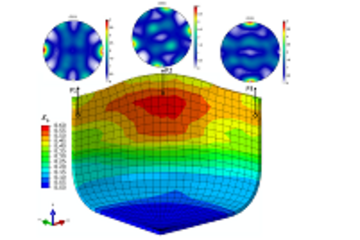All genres
841.
Talk
Fully ab initio determination of free energies: Where do we stand? TMS Spring Meeting, Orlando, FL, USA (2012)
842.
Talk
Nanostructuring of 1 Mio tons: Designing ultrastrong and ductile steels. DPG meeting (Deutsche Physikalische Gesellschaft), Berlin, Germany (2012)
843.
Talk
The art of experimentation in micromechanics: Lattice defects in steels. GAMM Conference, Darmstadt, Germany (2012)
844.
Talk
Joint DFT and TEM study on the ductilizing effect of rare earth elements (RE) on Mg alloys. TMS 2012 Annual Meeting, Orlando, FL, USA (2012)
845.
Talk
Crustacean skeletal elements: Variations in the constructional morphology at different hierarchical levels. DFG Winter School Priotity Programme 1420: "Biomimetic Materials Research: Functionality by Hierarchical Structuring of Materials", Potsdam, Germany (2012)
846.
Talk
Quantitativly optimized atomic orbitals (QUAMOLs) - SxQuamol. 1st International S/PHI/nX Developers Convention, Erkrath, Germany (2012)
847.
Talk
Ab-initio study of phase transitions in Magnetic Shape Memory Alloys. SPP1239 focus meeting, IFW Dresden, Germany (2012)
848.
Talk
Influence of alloying elements on solubility and diffusivity of H in different steel phases. HYDRAMYCROS Workshop, Ghent, Belgium (2012)
849.
Talk
Why do co-deformed composites have high strength after phase dissolution? SurMat Seminar 2012, Meschede, Germany (2012)
850.
Talk
Nanostructuring of 1 Million tons: Designing steels using quantum mechanics and atom probe tomography. Seminar Talk at University of Saarland, Saarbrücken, Germany (2012)
851.
Talk
Towards an ab-initio based understanding of H-embrittlement: An atomistic study of the HELP mechanism. Joint Hydrogenius and ICNER International Workshop on Hydrogen-Materials Interactions, Kyushu, Japan (2012)
852.
Talk
The dangling-bond defect in amorphous silicon: Insights from ab initio calculations of EPR parameters. 1st Austrian-German workshop on computational materials design, Kramsach, Austria (2012)
853.
Talk
Solution enthalpy of hydrogen in 3d transition metals and neighboring elements. 1st Austrian/German Workshop on Computational Materials Design, Kramsach, Austria (2012)
854.
Talk
Ab initio investigation of the stacking fault in Fe-based alloys. 1st Austrian-German workshop on Computational Materials Design, Kramsach, Austria (2012)
855.
Talk
Ab-initio calculation of phonons in disordered systems. 1st Austrian-German Workshop on Computational Materials Design, Kramsach, Austria (2012)
856.
Talk
Ab initio study of stability of Fe3Al surfaces in contact with an oxygen atmosphere. 1st Austrian/German Workshop on Computational Materials Design, Kramsach, Austria (2012)
857.
Talk
Atomic forces at finite magnetic temperatures: Phonons in paramagnetic iron. 1st Austrian/German Workshop on Computational Materials Design, Kramsach, Austria (2012)
858.
Talk
Point-defect energetics from LDA, PBE, and HSE: Different functionals, different energetics? 1.st Austrian/German Workshop on Computational Materials Design, Kramsach, Tyrol, Austria (2012)
859.
Talk
Understanding H-H interactions in fcc metals. 1st Austrian-german workshop on Computational Materials Design, Kramsach, Austria (2012)
860.
Talk
Arthropod cuticle: A biological multi-functional composite used as template for nano-to-macro-scale hierarchical modelling. EURO Bio-inspired Materials, International School and Conference on Biological Materials Science, Potsdam, Germany (2012)











